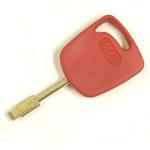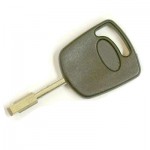Keys, colours and security.
Before we begin on PATS a little bit of info on keys, colours and security.
Ford Unsecured Keys up to 1994
This system is simply a key cut for your vehicle no programming required.
Ford Red Key System 1994 to 1998 this is what we have on Mk3 Fiestas
This system involves a red master key and 2 other user keys. The purpose of the red key is to put the car into programming mode to allow further keys to be programmed to your vehicle. Once you insert the Ford red master key, your car will enter programming mode. Then a further 2 keys cut for your vehicle must then be cycled in the ignition, each one being programmed in turn.
If you have lost your Master red key then the only way to program further keys is using professional key programming equipment to program a new master key, only then may further keys be added.
Ford 2 Key System 1998 to current
The transponders in the keys have varied over the years with this system. You must have at least 2 keys programmed for the vehicle. Once you have both keys programmed you can then add further keys without the need for professional equipment. This is done buy cycling the 2 programmed keys in your ignition in turn, thus putting your car into programming mode, then you can cycle a new key in the ignition and it will be programmed to your car.
Passive Anti Theft System
No nothing to do with a certain East Enders character but the acronym used by Ford for their internal anti-theft system. PATS stands for Passive Anti Theft System. To check that your fiesta has PATS fitted take a look at the key and see if it has a little red tab on the side of it. If your car does have PATS then the module is located on the left hand side of the dashboard in a metal casing, all the wires going to it are brown.


On the left a red master key. The right a standard key. On the side of this there will be a removable tab. This contains the code for the Pats module.
There is some confusion about what PATS is, and what it does. It is not part of the central locking or the alarm system, although it does share the red LED on the top of the dashboard. It is designed to be completely transparent so that it requires no action at all on the part of a driver, and always remains active, even if the doors are left unlocked and the alarm is off.
The PATS system was first a separate module mounted beneath the dashboard, and later became part of the engine management system, and is connected to a transceiver mounted around the ignition barrel. When the ignition key is not present, PATS disables all of the EEC V engine management, and on some models the starter as well. The PATS receiver awaits an ignition key with a transponder (the little red tag mounted in the key) which matches the code that PATS recognises. This is the clever part: even if a key is an exact physical match with the ignition lock and the key is turned, PATS checks the transponder code and if it is not recognised the engine is dead.
So the spotty dork who breaks in to steal the car smashes the steering shroud and rips away the electrical connection at the back of the barrel is wasting his time. The ignition switch itself will turn, but the engine management system has not received the OK from PATS and the engine remains stubbornly silent.
AHA, I hear you cry, what if I replace the PATS module? Well, apart from the expense, you will need the WDS 2000 diagnostic system and expert time in order to program PATS to the new system, and no main dealer is going to do that without checking the validity of the request, end of story. On later variants, the PATS is built into the EECV so that has to be changed – and yes, you need WDS to reprogram it.
What, cries another clever dick, if I remove the PATS fuse? Same thing, dummy. PATS has not given the ok and the EECV management system remains completely inert.
Programming new keys
The system itself assumes that there are three keys programmed into PATS. One is a red key, the master, and two slave keys, which are black and will have a red dot. The red master key should be locked away in a safe place and only the black keys should be in daily use. If a key is lost, the red master key can be used to program a new key. The following sequence is noted in the vehicle handbook.1. Obtain new key from main dealer ordered using the vehicle key number.
2. Insert red master key into ignition and turn to position II. When the red LED comes on switch off and remove the master key.
3. The LED goes off and then comes on for 2 seconds. PATS is now in programming mode for the next ten seconds.
4. Insert the new slave key. The LED will come on and go off to confirm that the key has been programmed. Switch off and remove the new key.
In the event that the red master key is lost, then a new one can be ordered using the vehicle key number. Be prepared to prove that you are the registered keeper of the vehicle because otherwise the main dealer should refuse. This master has to be programmed by a Main Dealer using WDS, which clears the PATS module memory and reassigns the new master. Once that is done, the old slave keys need to be reprogrammed as above.
Fault Finding
Although the red LED is used for the alarm and the PATS system, PATS has priority, and the LED can be used for fault diagnosis. The LED should always go out about three seconds after ignition on.
If there are less than three keys programmed into the PATS module the LED will stay on for one minute with the engine running, but if the LED flashes after that then careful attention should be paid because it may be a fault code.
The following checks can be made without WDS:
| The engine does not start and LED remains off. | 1. Check PATS system fuses 2. If alarm is fitted check if LED functions for alarm: if not check cigar lighter fuse (also used for LED) 3. If not go to main dealer |
| Engine does not start: LED flashes rapidly | Leave ignition on until the LED starts to flash a 2 digit code: (sequence- pause-sequence) Check the following codes: |
| Code flashes: | |
| 1:3 | Key code not received. Is key screened by other keys or objects? Try different key: if okay then first key is faulty. If not go to main dealer |
| 1:4 | Partial code only received. Try again. If not okay use different key. If not go to main dealer |
| 1:5 | Key not programmed into PATS. Program key as above using master |
| 1:6 | Faulty link between PATS module and EECV Go to main dealer |
If the LED illuminates for 4 seconds but the engine does not crank, PATS is working correctly and there is a fault elsewhere. Try starter solenoid or battery. If okay go to main dealer.
If the LED illuminates for 4 seconds and the engine cranks but does not start, PATS is working correctly and the fault lies elsewhere. Check the Fuel Cut-Off switch. If okay go to main dealer.
If none of the above checks resolves the problem then the system will need to be connected to WDS at a main dealer for a diagnostic check.
If the engine starts normally but the LED stays on, wait for one minute. The LED may then flash a code 2:1. This is showing a ‘fault’ that there are less than 3 keys programmed into PATS. One of more keys need to be programmed to stop this code.
Any other code needs referring to the Ford main dealer.